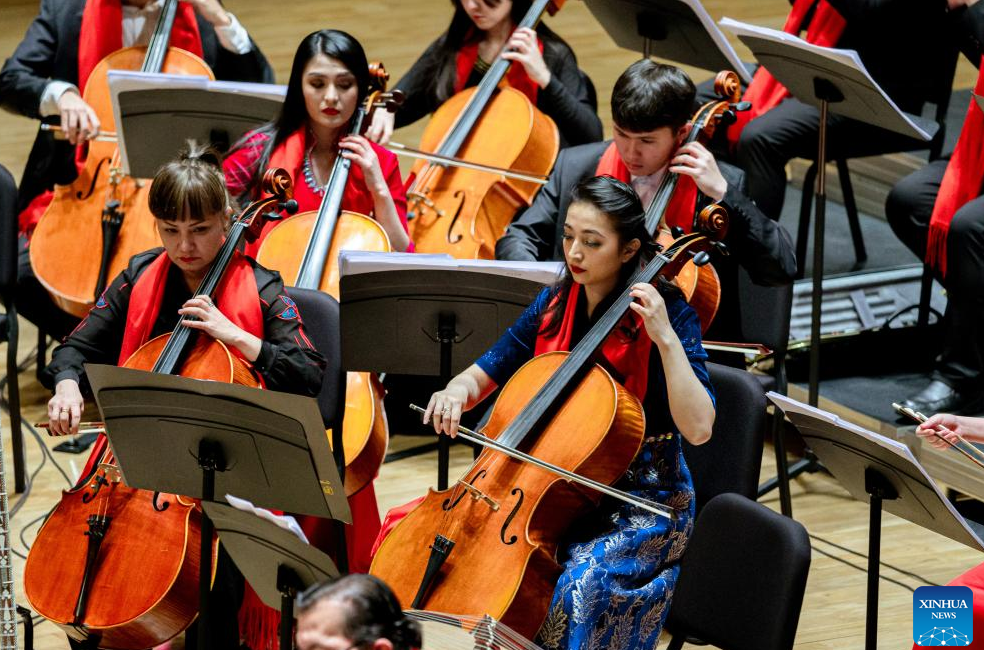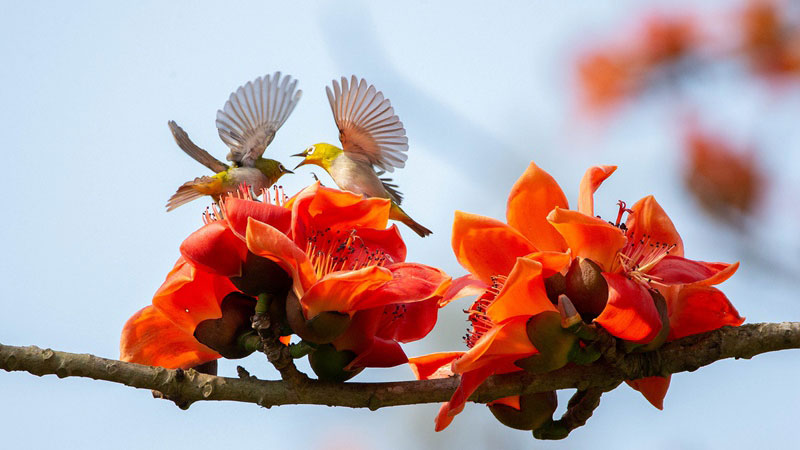Across China: Xinjiang folk orchestra makes its name through musical fusion

This photo taken on Jan. 14, 2023 shows the Chinese Lunar New Year concert presented by Xinjiang Art Theater's folk orchestra in Urumqi, northwest China's Xinjiang Uygur Autonomous Region. (Xinhua)
URUMQI, Jan. 25 (Xinhua) -- On hearing the duet of the Kazakh folk song "A Lovely Rose" and Italian opera "Nessun Dorma" (None Shall Sleep), Xu Dandan was a bit surprised, then soon enchanted by the chemistry generated from the unfrequent combination, especially the accompaniment of the gijak, a traditional Uygur bowed string instrument.
"The concert featured various musical instruments and music genres, and was excellently performed," said Xu after enjoying the Chinese Lunar New Year concert in Urumqi, capital of northwest China's Xinjiang Uygur Autonomous Region.
Presented by Xinjiang Art Theater's folk orchestra, the repertoires also encompass Western classics, folk music from other parts of China, and well-known tunes from Chinese movies -- all performed with Xinjiang's folk musical instruments such as rewap, dutar, satar, and gijak.
The orchestra is mainly composed of musical instruments played by Xinjiang's ethnic minorities, said Xu Zhijun, conductor of the concert. He added that its music embodies the flamboyant musical style along the Silk Road, thus possessing great potential for going global.
"It was wondrous and magical that (the performance) brought Xinjiang's music and Western music closer to each other both in terms of time and space," said Xu.
However, the lack of performance standards and a nationwide fanbase for Xinjiang folk music hindered the orchestra's rise to fame for a long time.
The endeavor to integrate Xinjiang folk music with Western music started 10 years ago, when Zhang Rui, now head of the orchestra, kicked off his career at the orchestra. "We wanted to broaden our market and shake off the stereotype of being 'rustic.' That's why we tried, for instance, works of Wolfgang Amadeus Mozart and Dmitri Shostakovich," he recalled.
Thanks to the bold experiment, musical fusion has now become a name card of the orchestra, attracting more and more conductors and performers to collaborate. The orchestra has toured more than 70 countries and regions globally. Meanwhile, a growing number of young musicians are joining.
For Adile Mahmut, a gijak musician, the orchestra is on the right track. "Western instruments like cello, bass, and trombone are used to fill in the bass parts that we lack, making our music more dense and luxuriant. I think we should try more (collaboration) so that more people will like our music," she said.
The 28-year-old learned to play both the gijak and violin from her father at the age of eight until her father decided that she should focus on gijak. "I used to consider playing the gijak a bit 'old-fashioned,' but not anymore," she said.
Characterized by its crisp, light sound, a gijak usually has two main strings and a spherical sound box. At its bottom is an extended knee rest for playing upright, rather than horizontally like a violin.
"Sometimes people may confuse a gijak with a violin or erhu," Adile Mahmut told Xinhua while practicing the instrument, explaining the differences between them. "After our recent concerts, I'm more convinced that the melodies of gijak can be heard from even more distant places in the world."
"These years, we're having more young musicians with us. I can see the confidence and pride in them. They're proficient and with broad horizons," Zhang said. "We're now on our way to take Xinjiang music to the whole country and the world."

This photo taken on Jan. 14, 2023 shows the Chinese Lunar New Year concert presented by Xinjiang Art Theater's folk orchestra in Urumqi, northwest China's Xinjiang Uygur Autonomous Region. (Xinhua)

This photo taken on Jan. 14, 2023 shows the Chinese Lunar New Year concert presented by Xinjiang Art Theater's folk orchestra in Urumqi, northwest China's Xinjiang Uygur Autonomous Region. (Xinhua)
Photos
Related Stories
- People’s Daily Online launches free medical program in remote Xinjiang village
- Erkin Tuniyaz elected chairman of China's Xinjiang Uygur Autonomous Region
- Xinjiang solicits public opinions about livelihoods on Leaders' Message Board
- Pic story: folk artists of Muqam in Xinjiang
- What it's like to celebrate Chinese New Year in Xinjiang
- Xinjiang to accelerate development in next 5 years
- World Islamic religious figures, scholars visit China's Xinjiang
- Strong measures help Xinjiang contain violent acts
- Altay Prefecture in Xinjiang aspires to boost winter tourism
- Interview: Xinjiang going forward in right direction: World Muslim Communities Council leader
Copyright © 2023 People's Daily Online. All Rights Reserved.









